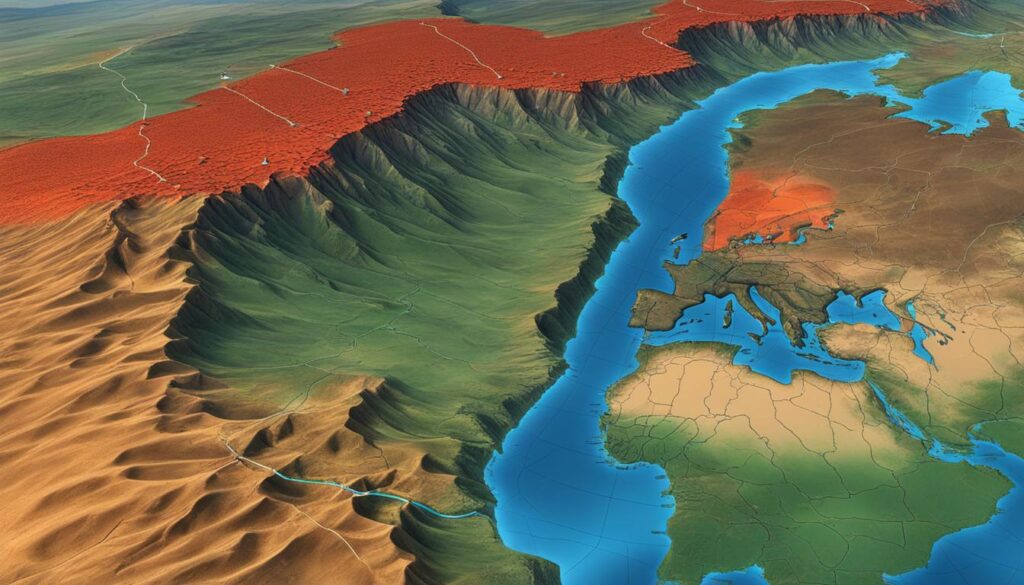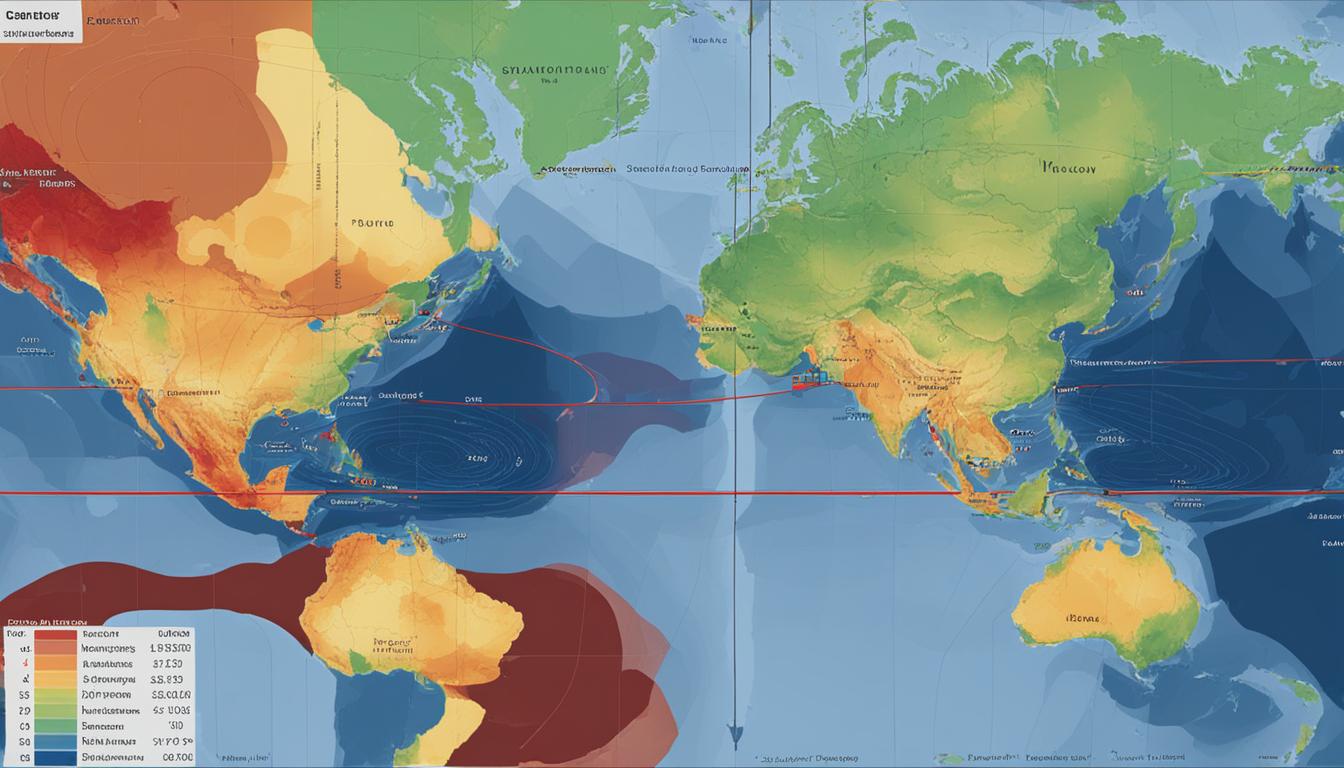When it comes to seismic activity, understanding the difference between shallow and deep earthquakes is crucial. The depth at which an earthquake occurs plays a significant role in determining its destructive force and impact on the Earth’s surface.
Most earthquakes occur at shallow depths, typically between 0 and 70 km. However, deep earthquakes can occur at depths between 70 and 700 km. While shallow earthquakes are more damaging due to their proximity to the surface, deep quakes are usually more widely felt.
Key Takeaways:
- Earthquakes can occur at different depths, with shallow and deep earthquakes being the most common.
- Shallow earthquakes occur between 0 and 70 km, while deep earthquakes occur between 70 and 700 km.
- Shallow earthquakes tend to be more destructive due to their proximity to the surface.
- Deep earthquakes can be felt over a wider area but are generally less damaging.
- Understanding earthquake depths is essential for comprehending seismic activity and assessing potential impacts.
Understanding Earthquake Magnitude and Depth
An earthquake’s magnitude and depth are crucial factors in determining its impact and potential for destruction. While the magnitude measures the amount of energy released during an earthquake, the depth refers to how far below the Earth’s surface the earthquake occurs.
Earthquakes can happen at different depths, ranging from shallow to deep. Shallow earthquakes have a depth of less than 70 kilometers, while deep earthquakes occur at depths greater than 70 kilometers. The depth of an earthquake can have significant implications for its effects on the surface.
One notable difference between shallow and deep earthquakes is the range at which they are felt. Shallow earthquakes, being closer to the surface, are usually felt over a smaller area, while deep earthquakes can be felt over a wider region. This is because seismic waves from shallow earthquakes have a shorter distance to travel before reaching the surface.
Additionally, the destructive force of an earthquake is not solely determined by its magnitude. Factors such as location, distance from the epicenter, and depth also play a role. For example, a shallow earthquake with a lower magnitude can potentially cause more damage if it occurs closer to populated areas, while a deep earthquake with a higher magnitude may have a lesser impact if it occurs in a less densely populated region.
| Shallow Earthquakes | Deep Earthquakes | |
|---|---|---|
| Depth | Less than 70 kilometers | Greater than 70 kilometers |
| Range of Felt Effects | Smaller area | Wider region |
| Potential for Damage | Higher if closer to populated areas | Lower if occurring in less populated regions |
Why Shallow Earthquakes Are More Damaging
Shallow earthquakes have a higher potential for causing significant damage compared to deep earthquakes. This is primarily due to the behavior of seismic waves. Seismic waves from shallow earthquakes have a shorter distance to travel to the surface, resulting in more intense shaking. In contrast, seismic waves from deep earthquakes have to travel a longer distance, causing them to lose energy along the way and resulting in less intense shaking at the surface.
The intense shaking caused by shallow earthquakes can be likened to setting off a bomb directly under a city. This level of shaking can put buildings, particularly those made of materials like brick or stone, at increased risk of collapse. Building codes play a crucial role in mitigating the damage caused by earthquakes. Areas prone to earthquakes have specific building codes in place to ensure structures are designed to withstand seismic forces. However, in regions where building codes are not strictly enforced or followed, the vulnerability to damage from shallow earthquakes is significantly higher.
“Seismic waves from shallow earthquakes can feel like setting off a bomb directly under a city.”
Another factor that contributes to the increased damage caused by shallow earthquakes is the presence of subduction zones. Subduction zones are areas where one tectonic plate is forced beneath another. These zones are often associated with intense seismic activity and can result in major earthquakes. The combination of shallow depths, intense shaking, and the presence of vulnerable structures in subduction zones can lead to devastating consequences.
Table: Comparison of Shallow and Deep Earthquakes
The Impact of Deep Quakes
While deep earthquakes are generally less damaging compared to shallow quakes, they can still leave a lasting impact. These deep-focus earthquakes, occurring at depths greater than 70 km, are often widely felt due to the long distance that seismic waves have to travel to reach the surface. One example is the earthquake that struck Myanmar, which caused significant destruction in the tourist town of Bagan.
In Bagan, nearly 100 brick pagodas dating back centuries were damaged, showcasing the vulnerability of historical structures to seismic energy. These structures, although not as numerous as the buildings affected by shallow earthquakes, hold cultural and historical significance, making their loss significant.
“The damage caused by deep earthquakes may not be as extensive as shallow quakes, but the loss of historical structures in places like Bagan is a reminder of the long-lasting impact of seismic activity.”
Understanding the impact of deep quakes goes beyond immediate destruction. It highlights the importance of preserving historical landmarks and building resilience in regions prone to deep-focus earthquakes. By studying the behavior of deep earthquakes and the effects they have on various structures, scientists can continue to refine their understanding of seismic events and mitigate future damage.
| Deep Quake Impact Factors | Description |
|---|---|
| Widely Felt | Seismic waves travel long distances to the surface, resulting in a wider affected area. |
| Historical Structures | While the overall damage may be less, the loss of cultural and historical sites can be significant. |
| Seismic Energy | Deep quakes can still generate substantial energy, although it may not cause as much immediate destruction as shallow quakes. |
Understanding Focal Depths of Earthquakes
Determining the focal depth of an earthquake is a complex process that involves analyzing seismograms. Seismograms are graphical records of the ground motion produced by seismic waves. Scientists can identify depth phases, such as pP and sP, on seismogram records to accurately determine the focal depth of an earthquake. These depth phases represent the reflection and refraction of seismic waves at various interfaces within the Earth’s interior.
By comparing the arrival times of depth phases with travel-time curves and depth tables, scientists can calculate the depth of the earthquake. Travel-time curves provide information about the expected travel times of seismic waves at different distances from the epicenter. Depth tables, on the other hand, contain the theoretical values for the arrival times of depth phases at various depths.
Deep-focus earthquakes, occurring at depths greater than 70 km, are localized within sinking slabs of lithosphere. As tectonic plates converge, one plate is forced beneath the other in a process known as subduction. Deep earthquakes are typically associated with subduction zones, where the sinking lithospheric slab generates intense pressure and temperature conditions that can trigger seismic activity.
Understanding the focal depths of earthquakes is crucial for studying the behavior of tectonic plates and the processes that drive seismic events. By analyzing seismograms and applying depth phase analysis, scientists can gain valuable insights into the complex dynamics of the Earth’s interior and improve our understanding of earthquake occurrence and distribution.
| Depth Phase | Description |
|---|---|
| pP | The first compressional wave reflected off the Earth’s surface |
| sP | The first shear wave reflected off the Earth’s surface |
| pS | The compressional wave converted to shear wave at the interface between the Earth’s mantle and outer core |
| sS | The shear wave converted to compressional wave at the interface between the Earth’s mantle and outer core |
| PKiKP | The compressional wave reflected off the interface between the Earth’s inner core and outer core |
Factors Affecting Earthquake Damage
The destructive power of an earthquake is influenced by multiple factors, including the epicenter, distance, location, and depth. Understanding these factors is crucial for assessing the potential impact of an earthquake and implementing effective measures to mitigate damage.
The epicenter, which is the point on the Earth’s surface directly above the earthquake’s focus, plays a significant role in determining the severity of shaking. Earthquakes that occur closer to highly populated areas can cause more destruction due to the proximity of vulnerable infrastructure and dense populations.
Distance from the epicenter is another critical factor in earthquake damage. The intensity of shaking decreases as distance from the epicenter increases. Therefore, structures located further away from the epicenter may experience less severe damage compared to those in close proximity.
The location of an earthquake also influences its impact. Earthquakes occurring in regions with vulnerable infrastructure or areas prone to landslides or liquefaction can cause more significant damage. Understanding the geological characteristics of a location can help assess the potential risk and develop appropriate building codes and regulations.
Table: Factors Affecting Earthquake Damage
| Factor | Explanation |
|---|---|
| Epicenter | The point directly above the earthquake’s focus, determining the proximity to populated areas and vulnerable infrastructure. |
| Distance | The further from the epicenter, the less intense the shaking and potential damage to structures. |
| Location | Areas with vulnerable infrastructure or geological characteristics like landslides or liquefaction may experience more significant damage. |
| Depth | Shallow earthquakes closer to the surface can cause more destruction, while deep earthquakes may be felt over a wider area without causing as much damage. |

Depth is also a factor that affects earthquake damage. Shallow earthquakes, occurring closer to the Earth’s surface, tend to cause more destruction due to the intense shaking experienced near the epicenter. In contrast, deep earthquakes, which occur at greater depths, are typically felt over a wider geographic area but may cause less damage to structures.
In conclusion, understanding the epicenter, distance, location, and depth of earthquakes is crucial for assessing their potential impact. By considering these factors, scientists, engineers, and policymakers can develop effective strategies to minimize damage and improve the resilience of communities in earthquake-prone regions.
Conclusion
Understanding the difference between shallow and deep earthquakes is crucial in comprehending seismic activity and its impact on the Earth’s surface. Shallow earthquakes, occurring closer to the surface, tend to be more damaging due to the intense shaking they produce. On the other hand, deep earthquakes are typically felt over a wider area.
Factors such as seismic waves, building codes, and the vulnerability of historical structures contribute to the varying levels of damage caused by earthquakes. Shallow earthquakes, with their proximity to populated areas and the potential for destructive shaking, pose a significant threat to buildings and infrastructure.
By studying earthquake depths, scientists can gain valuable insights into the behavior of tectonic plates and how they interact to generate seismic events. This knowledge is essential in predicting and preparing for future seismic activity. Understanding the complex dynamics of seismic energy release is crucial for implementing effective safety measures and mitigating the potential impact of earthquakes.
FAQ
What is the difference between shallow and deep earthquakes?
Shallow earthquakes occur at depths between 0 and 70 km, while deep earthquakes occur at depths between 70 and 700 km.
Are shallow earthquakes more damaging than deep earthquakes?
Yes, shallow earthquakes tend to be more damaging due to their proximity to the surface.
Why are shallow earthquakes more damaging?
Shallow earthquakes are more damaging because seismic waves don’t have to travel as far, resulting in intense shaking.
Can deep earthquakes still cause significant damage?
Yes, deep earthquakes can still have a significant impact, particularly on historical structures.
How is the depth of an earthquake determined?
The depth of an earthquake is determined by analyzing seismograms and identifying depth phases.
What factors affect the destructive force of an earthquake?
The distance from the epicenter, the location of the earthquake, and the depth all play significant roles in determining the extent of damage.
Why is understanding earthquake depths important?
Understanding earthquake depths provides valuable insights into the behavior of tectonic plates and seismic activity.
 Skip to main content
Skip to main content


